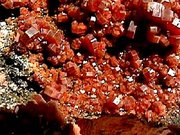Vanadinite
|
|
Vanadinite_USA.jpg
Vanadinite is a mineral with the formula Pb5(VO4)3Cl, lead chlorovanadate. It is part of a series with two other minerals: pyromorphite (Pb5(PO4)3Cl) and mimetite (Pb5(AsO4)3Cl).
It has hexagonal crystals, usually prismatic but the crystals are often skeletal or cavernous and it may be found in crusts. It is brittle and has an uneven fracture. The hardness of vanadinite is 2.75-3 and its specific gravity is 6.7-7.2. It has a resinous lustre and is coloured yellow, yellowish-brown, reddish-brown or red. It is translucent or opaque.
Vanadinite is not a common mineral, occurring as an alteration product in lead deposits. It is found in the Ural Mountains, Austria, Spain, Scotland, the Transvaal, Morocco, Argentina, Mexico and in the United States states: Arizona, New Mexico and South Dakota. It is used as an ore of vanadium and to some extent of lead as well. The mineral was first described as a chromate when it was discovered by Andrés Manuel del Río in Mexico in 1801, as the metal vanadium was not itself discovered until 1830.
See also
References
- Mineral Galleries (http://mineral.galleries.com/minerals/phosphat/vanadini/vanadini.htm)
- Mindat (http://www.mindat.org/min-4139.html)
- Webmineral (http://webmineral.com/data/Vanadinite.shtml)

